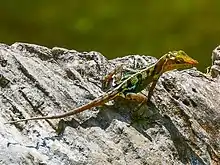Anolis vermiculatus
The Vinales anole (Anolis vermiculatus), also known as the Cuban stream anole, is a species of lizard in the family Dactyloidae, endemic to Cuba.[2][3]
| Anolis vermiculatus | |
|---|---|
 | |
| Scientific classification | |
| Domain: | Eukaryota |
| Kingdom: | Animalia |
| Phylum: | Chordata |
| Class: | Reptilia |
| Order: | Squamata |
| Suborder: | Iguania |
| Family: | Dactyloidae |
| Genus: | Anolis |
| Species: | A. vermiculatus |
| Binomial name | |
| Anolis vermiculatus Cocteau, 1837 | |
| Synonyms | |
| |
Range and habitat
A. vermiculatus is endemic to the Viñales region of Pinar del Río Province in western Cuba.[2] It lives in densely vegetated and heavily shaded habitats close to water, typically streams.[3][4]
Description and behavior
This blue-eyed species is a relatively large anole with males reaching up to 12.3 cm (4.8 in) in snout-to-vent length and females up to 8.3 cm (3.3 in).[4] It is one of only two anoles that completely lacks a dewlap (both sexes), the other being the West Cuban anole.[5][6]
A. vermiculatus is fast to retreat and will dive into water to escape potential enemies,[3][4] reportedly sometimes staying submerged for almost an hour.[7] It can also run bipedally across water, similar to A. lionotus, A. poecilopus and A. oxylophus (all often in Norops instead) from Central America and Colombia, as well as the basilisks.[4][8] A. vermiculatus feeds on small animals like frogs, shrimp and fish, which often are caught in water.[3][4] It is one of two semi-aquatic anoles from the Caribbean, the other being A. eugenegrahami of Hispaniola, and there are a few additional semi-aquatic anoles in Central and South America.[8][9] The semi-aquatic anoles are morphologically diverse and do not form a monophyletic group,[8] but there is convergence in certain microstructures of their skin, making it highly hydrophobic.[9] This results in a thin layer of air on the skin surface when submerged underwater, which they may use as an extra air supply for breathing, and it also prevents water from staying on when exiting the water.[9]
See also
References
- Fong, A. (2020). "Anolis vermiculatus ". The IUCN Red List of Threatened Species 2020: e.T75087328A75171896. https://www.iucnredlist.org/species/75087328/75171896. Downloaded on 29 March 2021.
- Uetz, P.; & J. Hallermann (2018). Anolis vermiculatus. The Reptile Database. Retrieved 14 March 2018.
- Losos, J.B. (2011). Lizards in an Evolutionary Tree: Ecology and Adaptive Radiation of Anoles, pp. 76, 343. University of California Press. ISBN 978-0-520-26984-2
- Lambert, S. (11 May 2014). Spotlight on Cuban Anoles III: Anolis vermiculatus. Anole Annals. Retrieved 14 March 2018.
- Losos, J. (2 April 2013). Anole Beach Party In Venezuela. Anole Annals. Retrieved 28 March 2018.
- Harrison; Mahler; Castañeda; Glor; Herrel; Stuart; Losos (2016). "Comparative tests of the role of dewlap size in Anolis lizard speciation". Proc Biol Sci. 283 (1845): 20162199. doi:10.1098/rspb.2016.2199. PMC 5204168. PMID 28003450.
- Lee, A.S. (Winter 2000). Lizard Island: Cuba is a study in saurian richness. Retrieved 15 March 2018.
- Leal, Manuel; Knox, Alison K. & Losos, Jonathan B. (2002). "Lack of convergence in aquatic Anolis lizards". Evolution. 56 (4): 785–791. doi:10.1554/0014-3820(2002)056[0785:lociaa]2.0.co;2. PMID 12038536.
- Baeckens, S.; Temmerman, M.; Gorb, S.N.; Neto, C.; Whiting, M.J. & Van Damme, R. (2021). "Convergent evolution of skin surface microarchitecture and increased skin hydrophobicity in semi-aquatic anole lizards". J Exp Biol. 224 (19): jeb242939. doi:10.1242/jeb.242939. PMID 34642763.
